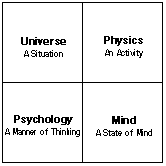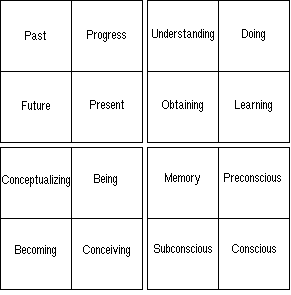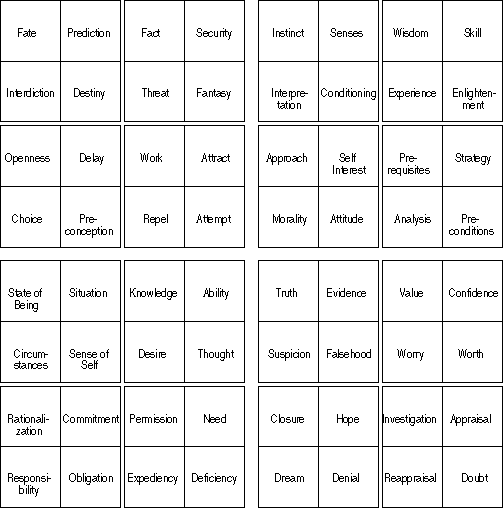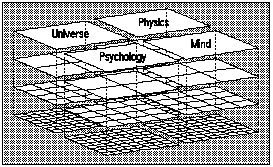Dramatica: A New Theory Of Story
By Melanie Anne Phillips & Chris Huntley
Chapter 12
The Elements of Structure:
Theme
What Exactly Is Theme?
It seems every author is aware of theme, but try to find one who can define it! Most will tell you theme has something to do with the mood or feel of a story. But how does that differ from genre? Others will say that theme is the message of the story. Some will put forth that theme is the premise of a story that illustrates the results of certain kinds of behavior.
Taking each of these a bit farther, a story’s mood or feel might be “anger”. A message might be “nuclear power plants are bad”. A premise could be “greed leads to self-destruction.” Clearly each of these might show up in the very same story, and each has a somewhat thematic feel to it. But just as certainly, none of them feels complete by itself. This is because each is just a different angle on what theme really is.
In fact, theme is perspective. Perspective is relationship. Theme describes the relationship between what is being looked at and from where it is being seen. This is why theme has traditionally been so hard to describe. It is not an independent thing like plot or character, but is a relationship between plot and character.
As a familiar example, think of the old adage about three blind men trying to describe an elephant. Each is like a character in a story, and their investigation of the beast is like the plot. One, feeling the tail comments, “It is long and thin like a snake.” Another, feeling the ear replies, “No, it is wide and flat like a jungle leaf.” The final investigator feels the leg and retorts, “You are both wrong! It is round and stout like a tree.” How each of those men felt about the elephant, how they understood it, depended upon his point of view, and the fact that it was an elephant. It is also true, that had another animal been the object of study, the perspective would have changed as well.
Where we are looking from are the four points of view represented by the four throughlines (Objective Story, Main Character, Obstacle Character, and Subjective Story). In stories, what we are looking at is the problem that the Story Mind is considering. So, to truly understand perspective (and therefore theme) we must be able to accurately describe the nature of the story’s problem, and then see how its appearance changes when seen from each different point of view.
Describing The Story’s Problem
When we seek to classify something, we try to narrow its definition, such as when we ask if something is animal, vegetable, or mineral. When classifying problems that might be of concern to the Story Mind, the first thing we might want to know is if the problem is an external issue (such as an intolerable situation) or an internal one (such as a bad attitude). External problems occur in the Universe (or environment), Internal problems occur in the Mind.
Further, some problems don’t have to do with states of things (an external situation or an internal attitude) but are processes that have gone awry. An external process falls in the category of Physics, which simply means physical activity of some kind. An internal process which results in a problem has to do with Psychology, which simply means a manner of thinking. Note that a manner of thinking (Psychology) is different than a fixed attitude (Mind). Psychology describes problems like spending too much time with details, whereas Mind problems would be more like a prejudice.
Having identified four categories by which we might classify the nature of the Story Mind’s problem, we can arrange them in a quad pattern, much as we did earlier with the Character Elements.

Since these four categories classify the problem, Dramatica refers to them as CLASSES.
More Resolution
So far, we have been able to roughly determine that a problem might be an external or internal state or process, represented by the four Classes. Already we can get a more refined view of the problem we will be describing in our story. We need only consider which of these four Classes best describes the problem about which we want to write.
For example, if we have an idea for a story about people trapped underwater in a sunken ship, that would be an external problem, best described as a state of things. An external state is the definition of a Universe problem, so this story idea takes place in the Universe Class.
If we wish to write about a harrowing trek through the jungle to a lost city, we are describing a Physics problem: an external activity from which difficulties arise.
A story exploring a father who will not let his daughter marry below her station in life is best described as a Mind problem, for it stems from a fixed attitude.
And finally, an author who wishes to comment thematically on a group of friends manipulating each other would select Psychology as his Class of problem, for the thematic issue at hand is changing one’s manner of thinking. Again, this differs from changing one’s Mind (about something).
It is important to note that ALL FOUR Classes will ultimately play a role in every complete Grand Argument Story. As we shall explore a bit later, each Class will describe the problem as it appears from a different throughline.
Domains
Earlier we illustrated how one could see four throughlines of Star Wars. Below are illustrations of how Star Wars‘ four throughlines would be seen in terms of Domains.
Star Wars
Objective Story Domain: Physics (the Class of Activities) — Star Wars is about a war between the Empire and the Rebellion. There is not any set location where this needs to take place, rather it is an exploration of the feints, attacks, and battles that occur between the two forces.
Main Character Domain: Universe (the Class of Situations)– Luke Skywalker is a whiny farm-boy from a small desert planet. He has a tremendous amount of unrealized talent because his father was a Jedi, but everyone sees him as a kid from the edge of the galaxy.
Obstacle Character Domain: Mind (the Class of Fixed Attitudes) — Obi Wan Kenobi lives in the world of the Force. His attitude about the Force’s power and impact, the existence of the Light and Dark sides of the Force, and the importance of the Force is unshakable.
Subjective Story Domain: Psychology (the Class of Ways of Thinking) — Obi Wan clearly manipulates Luke through psychological means. He attempts to coerce Luke to help him get to Alderaan, which Luke resists; Obi Wan does not reveal the fate of Luke’s aunt and uncle to Luke even though Obi Wan is clearly not surprised when he hears the news; Obi Wan purposely keeps Luke in the dark about his resources while bartering with Han Solo, hushing him up when Luke can barely contain himself; Obi Wan keeps Luke under his thumb by doling out information about the Force, the Empire, the Past, and everything else; and it’s Obi Wan who whispers into Luke’s head at several critical moments… “Run, Luke, run!” and “Trust your feelings, Luke.”
At this point, we have achieved a more clear understanding of our story’s theme by classifying the story’s problem. In our own lives, however, this would not be enough information to identify the problem clearly enough to begin solving it, and so it is with the Story Mind as well. We need to dig deeper and be more precise if we are to eventually pin-point the source of the story’s problem so it can be addressed at the root.
To increase our precision, we can sub-divide each of the Classes into different TYPES of problems within each Class, much as the classification “animal” and “vegetable” are sub-divided into various species.

As you can see, the TYPE level of resolution on our story’s problem is much more refined. Already the names of the Types carry much more of a thematic feel than those of the broad-stroke Classes. Some of the Types seem more familiar than others. This is because our culture has its own built-in biases and favorites and tends to focus on certain kinds of problems more than others.
If we compare the Types in one Class to those in the others, we can see how the chart does not cater to our culture’s biases. Rather, it presents a neutral set of sub-categories so that any kind of problem an author might wish to address is treated with equal weight.
One of the first things we can begin to feel about the Types is that their position within each quad has an influence on the nature of the Type, which is reflected in its name. For example, in the upper left hand corner of the Universe Class we find the Type, “Past.” By comparison, in the upper left hand corner of the Mind Class we find the Type, “Memory.” The balance of the chart can be easily illustrated in the phrase, “Past is to Universe as Memory is to Mind.” In fact, all of the categories and sub-categories we have explored (and the two remaining levels to be presented) share this kind of relationship.
We have found that it really helps to get a feel for a story’s problem by running this kind of comparison over in our minds as we examine the chart. Patterns of relationships begin to emerge, and the process of choosing the Class and Type of problem at the heart of our story’s theme becomes almost a game.
Concerns:
Choosing the Type most prominent in a particular throughline sets up the Concerns which will be most important from that point of view. To demonstrate how this might work, let’s look at the Concerns of Star Wars.
Star Wars
Objective Story Concern: Doing (Engaging in an activity)– The Empire is building the Death Star and searching for the location of the Rebels; the Rebels are attempting to keep their location secret; the smuggler is trying to deliver passengers to Alderaan to earn the money he needs to pay off his boss; the passengers are trying to transport the plans of the Death Star to the Rebels who will decipher the plans and launch an attack on the Empire.
Main Character Concern: Progress (The way things are going)– Luke Skywalker is constantly concerned with how things are going — “At this rate I’ll never get off this rock!” He is impatient and never satisfied with how things are progressing. Once he gets off of Tatooine, he is concerned with how long it will take for him to become a Jedi Knight — the progress of his training. When Obi Wan gets sliced by Darth Vader, Luke’s loss is compounded by the fact that he has lost a friend and a tutor. When they get to the Rebel base, he is concerned about how preparations are going and eventually with his own progress as a pilot in the Rebel attack on the Death Star.
Obstacle Character Concern: The Preconscious (Immediate responses)– In order to be truly “one with the Force,” a persons must completely let go of himself and let the Force act through him. This allows the Force to guide one’s unthinking responses and reflexes and to become an unbeatable power for good or evil. This is Obi Wan’s greatest concern and his efforts here impact everyone around him, especially Luke.
Subjective Story Concern: Being (Temporarily adopting a lifestyle)– Obi Wan wants Luke to be the faithful student, while Luke just wants to be a Hero without really understanding what good it does to be quiet and controlled like Obi Wan. Luke’s farm-boy lifestyle is not at all in sync with his true nature as Obi Wan sees him. Obi Wan knows that Luke is the son of a Jedi and therefore he tries to manipulate Luke out of being what he’s not.
Limitations of space prevent us from describing each and every Type through example. At the back of this book, however, you will find an appendix with a complete definition of each, as well as reproductions of the complete chart of categories.
Even with this degree of refinement, our story’s problem has still not been identified with the precision required to truly focus our theme. It is time to move into the next level of the problem chart.
When we sub-divide the Types, we can establish four different VARIATIONS of each. This creates the extended chart below:

Now we can finally begin to see some familiar thematic topics: morality, fate, commitment, and hope, for example. We can also see a number of unfamiliar terms that we may not have considered before in regard to theme. As before, Western culture (as do all cultures) favors certain areas of exploration and virtually ignores others. For an author who wishes to explore new ground, these unfamiliar terms provide a wealth of options. For the author who writes for the mainstream, all the old standbys are there, but with much more detail than before.
One thing you will not find on this chart are terms like “love” or “greed.” Although these concepts figure prominently in many discussions of theme, they are more descriptive of subject matter, rather than the perspectives one might take about that subject matter. For example, suppose we decide to write a story about love. All right, what kind of love? Brotherly love? Romantic love? Paternal, lustful, spiritual, or unrequited love? Clearly, love is in the eye of the beholder. In other words, love is shaded by the nature of the object that is loved.
In our chart of Variations, we find terms such as “Attraction”, “Obligation”, “Desire”, or “Instinct”, each of which can be used to describe a different kind of love.
Similarly, you won’t find “Greed” on this chart, but you will find “Self-Interest” (near the lower left corner of the Physics Variations). “Self-Interest” is not as emotionally charged as “Greed” but it more clearly defines the issues at the center of a rich man’s miserliness, a poor man’s embezzlement, and also a loving parent who must leave her child to die in a fire in order to save herself. And other Variations like “Fantasy”, “Need”, “Rationalization”, or “Denial” would each reflect a different kind of “Greed”.
It is not our purpose to force new, sterile and unfamiliar terminology on the writers of the world. It is our purpose to clarify. So, we urge you to pencil in your favorite terms to the chart we have provided. Stick “love” on “Attraction”, place “Greed” on “Self-Interest”, if that is how the most seem to you. In this manner, you will create a chart that already reflects your personal biases, and most likely incorporates those of your culture as well. The original bias-free chart, however, is always available serve as an neutral framework for refining your story’s problem.
As a means of zeroing in on the Variation that best describes the thematic nature of your story’s problem, it helps to look at the Variations as pairs. Just as with characters, the Variations that are most directly opposed in nature occur as diagonals in the chart. A familiar dynamic pair of Variations is Morality and Self-Interest. The potential conflict between the two emerges when we put a “vs.” between the two terms: Morality vs. Self-Interest. That makes them feel a lot more like the familiar kind of thematic conflict.
Later we shall return to describe how each dynamic pair in the chart can form the basis for a thematic premise in your story. We will also show how this kind of dynamic conflict does not have to be a good vs. bad situation, but can create a “lesser of two evils” or “better of two goods” situation as well.
Ranges
Identifying the Variation which is most suited to the central explorations of a throughline sets up the Range of thematic concepts to be explored from that point of view. To demonstrate how this might work, let’s look at the Ranges of Star Wars.
Star Wars
Objective Story Range: Skill (Practiced ability)– Everyone in this galaxy compares themselves to one another in terms of their skills; piloting a spacecraft, fighting their way out of tight situations, and standing up for themselves. The princess immediately evaluates her rescuers (Han, Chewbacca, and Luke) in terms of their apparent lack of skill. The entire war between the Rebellion and the Empire is a match between skills and experience. The Empire has a great deal of experience in quashing upstart groups, but its skills at doing so are rusty. The Rebellion, which has far less experience, is made up of great numbers of raw talent like Luke. Skill is an advantageous quality in this story.
Main Character Range: Fantasy (Belief in something unreal)– Fantasy is an important part of Luke Skywalker’s life. He has no idea what wars are really like, but he wants to hear all he can about them because his fantasy is to be a hero in one. He plays with toy space ships, he is intrigued by messages from damsels in distress, and he cares more about these fantasies than about the hum-drum life of farming on a desert planet. These fantasies help set him apart from the unimaginative people around him (e.g. his uncle), yet they also make him seem exceedingly inexperienced and naive (as he is almost killed in Mos Isley cantina). Fantasy is advantageous for Luke.
Obstacle Character Range: Worth (A rating of usefulness or desirability to oneself)– Obi Wan’s impact forces considerations of what should be thought to have true worth (as opposed to objective value). Obi Wan makes it clear that he believes the Force is what everyone should see as having the greatest worth in the galaxy, and then he backs up his opinion by using it to get himself and others out of tight jams. He also appears at first to be a nutty old hermit, but is revealed to be a person of great worth in the eyes of Princess Leia, an important leader in the Rebellion. Because Obi Wan shows that things are seldom what they seem, his impact often causes people to reevaluate what they find of worth and what they don’t. These re-evaluations of worth generally lead to a greater understanding — especially for Luke Skywalker. Obi Wan shows Worth to be advantageous.
Subjective Story Range: Ability (The innate capacity to do or be)– The most focused aspect of Luke’s and Obi Wan’s relationship has to do with developing the abilities of a Jedi Knight. When Luke is either improving his own abilities or admiring Obi Wan’s, everyone sees this relationship as a positive one for both people involved. Obi Wan’s influence helps Luke see abilities which he didn’t ever allow himself to see, such as the ability to leave home and join the Rebellion. Clarifying these abilities, however, would not be positive to their relationship if these two didn’t also share similar desires. Fortunately for them, every time Obi Wan uncovers a new ability, such as being able to use a light saber without looking, it makes Luke want more. These kinds of demonstrable abilities make others, such as Han Solo, see that there really is something good happening between this teacher and student–even if it does involve ancient religion. Ability in this relationship is advantageous.
We still have one final level of the thematic chart of a story’s problem to encounter. In fact, we have already encountered it. It is the very same chess set of sixty four Character Elements we created earlier:

Each Variation can be sub-divided again into four Elements. And, it turns out that when we get to the heart of the thematic issues in a story, no matter what kind of problem we began with it all comes down to the same thing: Character. Not surprising at all, really. Characters represent the different ways the Story Mind can go about solving the story’s problem. The Main Character sits on the Crucial Element, and must either stick with it, if it is the solution, or abandon it if it turns out to be the problem itself.
Problems
Identifying the Element at the heart of each throughline puts a specific name on the Problem which drives that throughline through the story.
Star Wars
Objective Story Problem: Test (A trial to determine something’s validity)– Rather than trusting in the design and efficiency of the Death Star, the Empire determines it must have a test run on Alderaan. This clues Princess Leia, Obi Wan, and subsequently the Rebellion, as to the terrifying nature of what they are facing. This also allows the Rebellion forces to prepare for the worst which is the Empire’s undoing. The Rebellion, on the other hand, does not fully trust their information about the Empire’s secret weapon and tests its accuracy by waiting until they actually have the plans in their hands. Had they trusted their initial reports they could have moved the base and remained out of the Empire’s reach.
Main Character Problem: Test (A trial to determine something’s validity)–Luke is constantly driven to test his skills — as a wannabe Jedi, as a daring doer, as a marksman, and eventually as a pilot. By constantly testing himself, he gets into situations that he would have avoided if he had confidence (or trust) in himself. For example, he knew better than to go alone into the Sand people’s territory; the scuffle he created at the bar could easily have been avoided; the messy breakout of the Princess was partially motivated by his testing his limits.
Obstacle Character Problem: Unproven (A rating of knowledge that has not been tested)– Due to his devout faith in the Force, Obi Wan is driven by the idea that everything remains unproven — even if common sense might dictate otherwise. He finds exceptions to every generality that people mention around him. The impact of his character is to make others draw their most cherished beliefs into question, because the true nature of “the Force” is so unimaginable, yet so powerful.
Subjective Story Problem: Non-Accurate (Not within tolerances)– Obi Wan’s secrecy and misleading comments to Luke keeps their relationship off balance. Obi Wan attempts to lure Luke away with him to Alderaan, then feigns indifference when Luke wimps out; Obi Wan marginally warns Luke to be careful at the cantina without giving Luke a real idea of the dangers within; Obi Wan’s vagueness about the necessary “pains” associated with Luke’s Jedi training (like getting zapped by the trainer robot) jostles their relationship.
We need to take a breather here! Much new material has been covered and it takes quite some time to assimilate. We suggest you put the book down for a while, ponder what we’ve just explored, have a snack, watch a program on TV, and then return once the dust has settled. If we could, we’d provide some soothing mood music right about now. Since that is a bit difficult, we’ll do the next best thing – pull it all together in a simplified image.
Because each level “falls” under the one above it, we can create a “3-D” representation of the thematic chart that illustrates its nested nature:

The Dramatica Structural Model
This projection gives a good feel for how Classes, Types, Variations, and Elements relate to one another. We start at the top by loosely classifying our story’s problem, then sub-divide each Class into Types. Each Type is refined into Variations and then defined in terms of its basic Elements. Remember, our purpose here is only to identify the components of theme. Later in THE ART OF STORYTELLING we will illustrate how to construct and develop your story’s theme.

